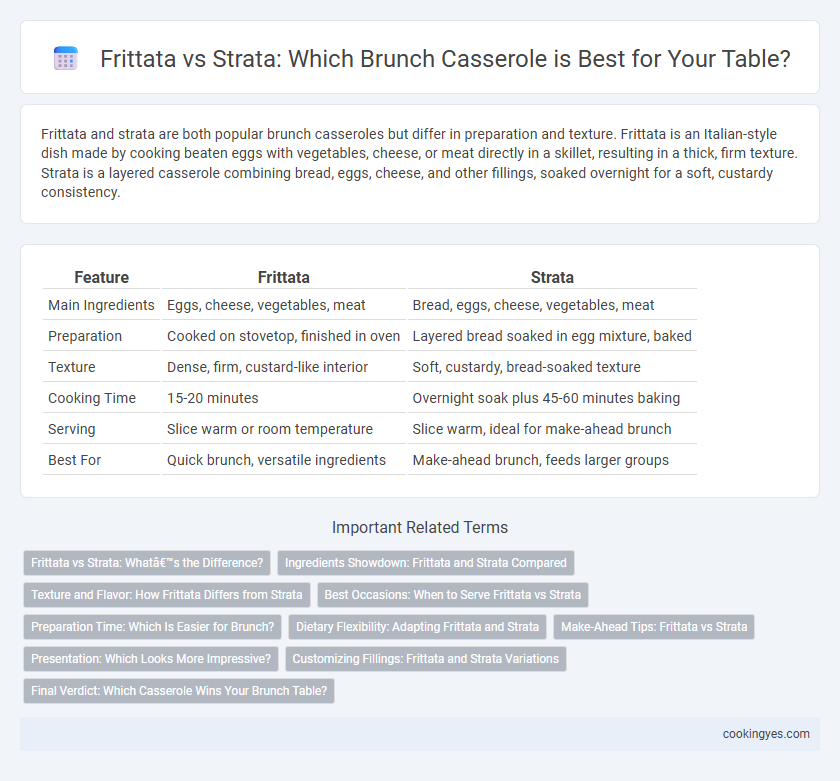Frittata and strata are both popular brunch casseroles but differ in preparation and texture. Frittata is an Italian-style dish made by cooking beaten eggs with vegetables, cheese, or meat directly in a skillet, resulting in a thick, firm texture. Strata is a layered casserole combining bread, eggs, cheese, and other fillings, soaked overnight for a soft, custardy consistency.
Table of Comparison
| Feature | Frittata | Strata |
|---|---|---|
| Main Ingredients | Eggs, cheese, vegetables, meat | Bread, eggs, cheese, vegetables, meat |
| Preparation | Cooked on stovetop, finished in oven | Layered bread soaked in egg mixture, baked |
| Texture | Dense, firm, custard-like interior | Soft, custardy, bread-soaked texture |
| Cooking Time | 15-20 minutes | Overnight soak plus 45-60 minutes baking |
| Serving | Slice warm or room temperature | Slice warm, ideal for make-ahead brunch |
| Best For | Quick brunch, versatile ingredients | Make-ahead brunch, feeds larger groups |
Frittata vs Strata: What’s the Difference?
Frittata and strata are popular brunch casseroles that differ primarily in preparation and texture. Frittatas are egg-based dishes mixed with vegetables, meats, or cheeses, cooked slowly on the stovetop and finished under a broiler, resulting in a dense, firm texture. Strata, on the other hand, incorporates bread soaked in a custard mixture of eggs, milk, and cheese, baked until puffed and golden, creating a layered, souffle-like consistency.
Ingredients Showdown: Frittata and Strata Compared
Frittatas primarily consist of beaten eggs mixed with various ingredients like vegetables, cheese, and meats, cooked slowly over the stovetop and finished in the oven, maintaining a dense, firm texture. Strata combines layers of bread, eggs, cheese, and other fillings, soaking overnight to create a custard-like consistency, making it ideal for advance preparation. The key ingredient difference lies in strata's inclusion of bread, which absorbs the egg mixture for a softer, pudding-like brunch casserole compared to the frittata's egg-forward structure.
Texture and Flavor: How Frittata Differs from Strata
Frittatas have a dense, creamy texture due to the direct cooking of beaten eggs with ingredients, creating a uniform, rich flavor throughout. Stratas, by contrast, incorporate layers of bread soaked in an egg mixture, resulting in a lighter, custard-like texture with a more complex flavor profile from the bread soaking up the seasonings. The difference in preparation methods directly influences the frittata's firm consistency versus the strata's moist, bread-enhanced bite.
Best Occasions: When to Serve Frittata vs Strata
Frittatas are best suited for quick, casual brunches or light meals due to their simple preparation and emphasis on fresh ingredients, making them ideal for weekday breakfasts or intimate gatherings. Stratas, with their bread base and longer baking time, work well for larger celebrations or holiday brunches where a hearty, make-ahead casserole can serve many guests efficiently. Choosing between frittata and strata depends on the occasion's scale and desired preparation time, ensuring convenience and flavor align with the event's needs.
Preparation Time: Which Is Easier for Brunch?
Frittatas require less preparation time as they combine beaten eggs with vegetables, cheese, and meats directly cooked in a skillet, making them quicker to assemble and cook. Stratas involve layering bread, cheese, eggs, and other ingredients, then soaking overnight, which extends the preparation time significantly. For a faster brunch casserole option, frittatas are easier and more efficient to prepare.
Dietary Flexibility: Adapting Frittata and Strata
Frittatas offer greater dietary flexibility with their simplicity, allowing easy incorporation of diverse vegetables, meats, and cheeses without the need for bread, ideal for low-carb or gluten-free diets. Stratas, involving layers of bread soaked in eggs and milk, provide a heartier, carb-rich option that can be adapted with various fillings but are less suitable for gluten-sensitive individuals. Both dishes accommodate vegetarian variations, though frittatas excel in quick customization for specific dietary restrictions.
Make-Ahead Tips: Frittata vs Strata
Frittatas require minimal prep and can be made ahead by assembling the egg mixture and fillings, then stored in the refrigerator for up to 24 hours before baking, ensuring freshness and ease of last-minute cooking. Stratas benefit from a longer soak time, ideally overnight, allowing bread cubes to absorb the custard base fully, which enhances texture and flavor development. Both dishes can be baked directly from the fridge, but stratas demand earlier preparation to achieve their signature custardy consistency, whereas frittatas remain firmer with a quicker prep-to-bake timeline.
Presentation: Which Looks More Impressive?
Frittatas boast a vibrant, colorful presentation with visible layers of eggs, vegetables, and meats often garnished with fresh herbs, making them visually appealing as individual portions. Strata, baked as a casserole, offers a rustic, golden-brown top crust that slices into thick, hearty servings, providing an impressive, shareable centerpiece for brunch. The frittata's open-faced style highlights ingredient textures, whereas the strata's layered structure creates depth and richness in appearance.
Customizing Fillings: Frittata and Strata Variations
Frittata and strata offer versatile bases for brunch casseroles, enabling numerous customization options. Frittatas feature a simple egg mixture combined directly with fillings like vegetables, cheese, or meats for a dense, custardy texture, while strata incorporate layers of bread soaked in an egg and milk mixture, lending a richer, bread-pudding consistency. Both variations support personalized ingredients, with frittatas favoring quick, varied inclusions and strata benefiting from overnight soaking to meld flavors and create hearty, flavorful dishes.
Final Verdict: Which Casserole Wins Your Brunch Table?
Frittata offers a rich, egg-centric texture with vegetables and cheese mixed evenly, creating a dense, protein-packed dish ideal for brunch. Strata layers bread with eggs, cheese, and fillings, resulting in a bread-based casserole that soaks up flavors and offers a more custard-like consistency. Choose frittata for a quicker, nutrient-dense option or strata for a hearty, make-ahead casserole that pleases a crowd.
Frittata vs Strata for brunch casseroles Infographic

 cookingyes.com
cookingyes.com